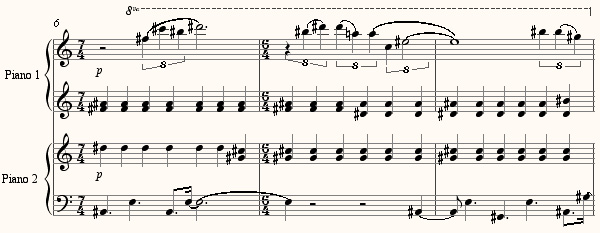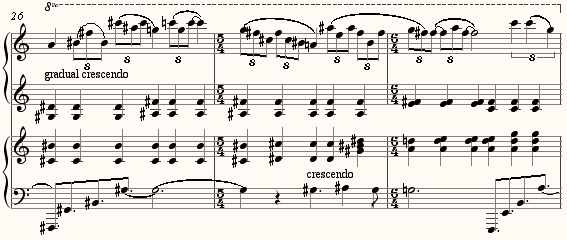For whatever reason, I was never much drawn to the type of nested 3:2 and 4:3 crossrhythms that I described in my last metametrics post, but I did use it once, and could have mentioned it. In 1985, on the verge of turning 30, I was under some psychological pressure to write something ambitous. I decided on a big set of variations for two pianos, somewhat inspired by the two-piano tradition of Busoni’s Fantasia Contrappuntistica, Wallingford Riegger’s Variations, The Art of Fugue, and such huge solo piano variations as the Diabelli and Brahms’s Handel. (This was before Larry Polansky wrote his Lonesome Road Variations, which dwarfed mine.) My I’itoi Variations was a set of eleven variations on the “Black Mountain†song from the I’itoi cycle of the Papago Indians. I was very involved in collecting, transcribing, and analyzing American Indian music in those days, because I was attracted to its, um, proto-totalist rhythmic character – specifically the way it shifted back and forth among tempos.
Another influence on I’itoi Variations (and on much of my music) was Beethoven’s Op. 111 Sonata – variations 1 through 6 were stormy and tense like Beethoven’s first movement, variations 7 through 10 were impersonal and calm like the second movement, and no. 11, in an attempted tour de force, went back through the first ten variations in reverse order. Variation 8 was based on a nested 3:2. The idea was simple. (I try to make all my ideas simple). There were two foreground lines, the bass line in piano 2 and the right-hand melody of piano 1, plus a line of quarter-note chords shared by both pianos. The bass was in dotted quarters, the treble in triplet quarters, for a 4:6:9 tempo resultant. I hoped the treble and bass would float in seeming unrelatedness to each other, though subtly mediated by the chords in between. Here’s a passage from the beginning of the variation:

and another from the end, where the treble and bass lines have doubled in tempo:

The bass line is the inversion of the theme, with the intervals doubled in size (a trick I picked up from Messiaen’s bird song music). I suppose it won’t much harm my reputation to admit that the changes of key are timed according to a descending sequence of Fibonacci numbers. Everyone who studied Bartok’s music had to try them once. This was back in 1985 when I had not yet heard of Mikel Rouse, Michael Gordon, or Art Jarvinen, and was blissfully unaware that they were using the same ideas.
Here’s the recording of Variation 8 from I’itoi Variations, played by the Double Edge duo – Nurit Tilles and Edmund Niemann, who premiered it at Cooper Union in New York circa 1990.
